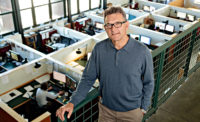Seismic engineering innovators often hit resistance to change, but Steven Tipping knows this. For years, he has been seeking ways to build better mousetraps—in earthquake zones.
 |
| Tipping |
"When you're on the cutting edge, you have to turn around and convince the masses, who are wired against innovation," says Tipping, president of Tipping Mar (TM). "It's an uphill battle."
But thanks to Tipping's initiative, TM was able to fast-track one structural innovation and save the day for the stalled $145.5-million San Francisco Public Utilities Commission Headquarters. TM's scheme, developed as a value engineering exercise during the construction-document phase, saved $5 million, improved the architecture, scored points for structural resilience and added an extra floor.
Used for the first time at such a scale, TM's system relies on unbonded vertical post-tensioning (PT) in concrete core walls to resist lateral loads. It is designed to limit structural damage by replumbing the structure after a major quake. The aim is to allow immediate re-occupancy.
"Steve has the rare balance of solid technical ability, creativity and collaboration [skills] coupled with honesty and humility," says Phil Williams, a vice president of Webcor Builders, which built the 13-story building.
Richard M. Kunnath, president of the Charles Pankow Foundation and another ENR Newsmaker (see p. 45), adds, "Steve has indefatigable determination to see his ideas reach reality." That involves leading building-code changes and convincing others to advance his concepts, he says.
Pankow is funding TM-led research that involves developing criteria, based on load tests scheduled for this year, to add vertical-PT walls to the building code.
But thanks to the slow pace of adoption, it could take eight years for the code to change. Undaunted and perhaps drawing on perseverance acquired while in the Army in Vietnam, Tipping continues to seek ways to innovate. "We are very interested in doing a 20- or 30-story PT buildings," he says. "The extra height is the sweet spot for seismic performance."




Post a comment to this article
Report Abusive Comment